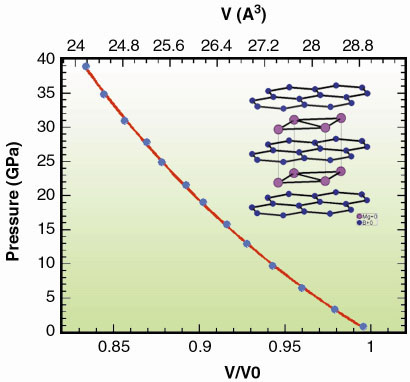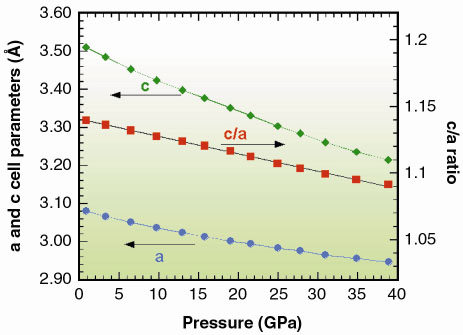- Home
- Users & Science
- Scientific Documentation
- ESRF Highlights
- ESRF Highlights 2001
- Materials
- High-Pressure Study of the 40 K Superconductor MgB2
High-Pressure Study of the 40 K Superconductor MgB2
The report by the team of Akimitsu [1] of a superconducting transition temperature as high as 40 K in MgB2, a compound which has been known for a long time, was probably one of the most unexpected discoveries of year 2001 in the field of solid-state physics. It soon led to a large variety of experimental and theoretical work aimed at understanding the reasons for such a high Tc in this simple compound. Among these, the knowledge of the high-pressure behaviour can provide insight into the origin of superconductivity, as was demonstrated in the case of the high Tc cuprates. We have therefore undertaken a study of the electrical and structural properties of MgB2 up to 40 GPa.
 |
Fig. 119: Experimental data and fit to the equation of state for MgB2 (the crystal structure is shown in the inset). |
Magnesium diboride has the AlB2-type hexagonal (P6/mmm) structure, with a = 3.08Å, c = 3.51 Å (inset of Figure 119). The structure can be described as the alternate stacking of planes of boron atoms forming a honeycomb lattice, and planes of magnesium atoms forming a triangular one. The equation of state of MgB2 was determined up to ~39 GPa by angle-resolved X-ray diffraction ( = 0.3738Å) at ID30, the high-pressure beamline, using a membrane-driven diamond anvil cell with diamond tips of diameter 300 µm and stainless-steel gaskets with holes of 120 µm. Nitrogen was used as the pressure transmitting medium in order to keep good hydrostatic conditions. The pressure was determined using the ruby fluorescence method. The diffraction patterns were recorded with a Mar345 image plate detector located at 360 mm from the sample and transformed into powder diffractograms using the Fit2D software. These data were successfully refined by the Rietveld technique with the AlB2-type structure up to the highest pressure of ~39 GPa investigated.
In Figure 119 we show the observed p(V) dependence; the line represents the fit to the observed points using the Vinet equation of state:
where fV = (V/V0)1/3, and B0, B'0 and V0 are the bulk modulus, its derivative and the cell volume at room pressure, respectively. The values obtained were B0 = 150(5) GPa, B' = 4.0(3) and V0 = 29.00(4) Å3, the latter being in excellent agreement with theoretical calculations. Figure 120 shows the evolution with pressure of the a and c cell parameters and c/a ratio. Both cell parameters decrease monotonically with increasing pressure. No sign of a phase transition is seen. The solid line in the figure represents a linear fit to the data, with a slope of 1.3 10-3 GPa-1. The similar values of the a- and c-axis compressibility (1.9 10-3 GPa-1 and 3.1 10-3 GPa-1) indicate an almost isotropic behaviour, contrasting with the layered-type structure and the different nature of the chemical bonds in the in-plane and out-of-plane directions.
 |
Fig. 120: Variation of cell parameters with applied pressure for MgB2. |
Our resistivity measurements under pressure suggest that the dependence of Tc can be naturally explained by considering that the 2D pxy holes are the driving carriers for superconductivity. Although a structural instability has been reported by others in Al substituted compounds, we do not observe any crystallographic transition despite the fact that we reach values of the cell parameters at the highest pressures, which are smaller than those of AlB2.
Reference
[1] J. Nagamatsu, N. Nakagawa, T. Muranaka, Y Zenitani and J. Akimitsu, Nature 410, 63 (2001).
Principal Publication and Authors
P. Bordet (a), M. Mezouar (b), M. Nùnez-Regueiro, M. Monteverde (c), M.D. Nùnez-Regueiro (d), N. Rogado, K.A. Regan, M.A. Hayward, T. He, S.M. Loureiro and R.J. Cava (e), Phys. Rev. B64, 172502 (2001).
(a) Laboratoire de Cristallographie, CNRS, Grenoble (France)
(b) ESRF
(c) CRTBT, CNRS, Grenoble (France)
(d) Grenoble High Magnetic Field Laboratory, MPI-KFK and CNRS, Grenoble (France)
(e) Department of Chemistry and Materials Institute, Princeton University (USA)



